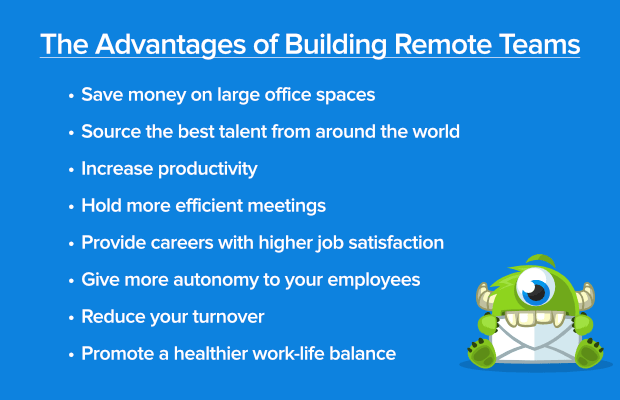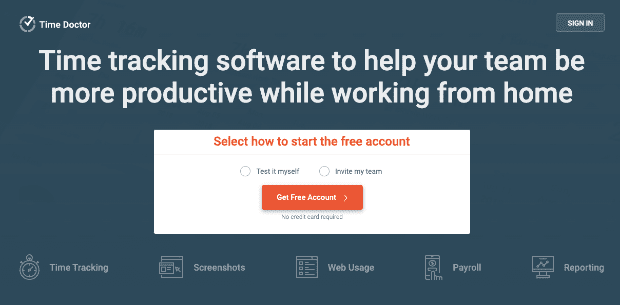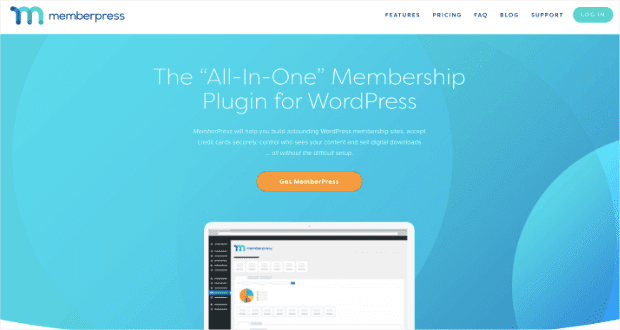Are you the owner of a business who is considering letting your staff work from home? Remote work can have tons of benefits for your company, but it can be scary to make that leap.
That’s why we’ve created the ultimate work from home checklist to help you empower your newly-remote staff. When done correctly, letting your employees work from home can be one of the best business decisions you make.
And by the end of this article, you’ll see exactly why.
So let’s dive in and learn how to help your employees move from on-site to remote work.
The Advantages of Having a Remote Team
As a company that’s always been 100% remote, OptinMonster knows a thing or two about its advantages. Frankly, we couldn’t think of doing business any other way.
Check out some of the major advantages of building a remote team:
- Save money on large office spaces
- Source the best talent from around the world
- Increase productivity
- Hold more efficient meetings
- Provide careers with higher job satisfaction
- Give more autonomy to your employees
- Reduce your turnover
- Promote a healthier work-life balance
Need we go on?
The fact is that research predominantly promotes working from home as the most efficient business model. And if you’re not totally convinced yet, just check out some of these surprising statistics on the subject sourced from Flexjobs:
- 85% of businesses confirm that productivity has increased in their company after going remote
- 90% of employees say more flexible work arrangements would increase employee morale
- Remote workers are 57% more likely than the average American to be satisfied with their job
- 65% of remote workers are more productive in their home office than at a traditional workplace
- 50% of remote employees said working from home reduced their sick days, and 56% said it reduced their absences
And these findings aren’t the outliers. So if remote teams appear to bring loads of good without the bad, why don’t more companies make the shift?
Because this kind of change can be scary.
Many business owners fear that their employees will spend their days watching Netflix or wasting time on Facebook. And, sadly, sometimes they’re right.
But the overwhelming evidence suggests that this is more of a hiring problem than anything else. And if you’ve got a team you trust, you should have no problem transitioning from an in-house company to a 100% remote team.
Just to be safe, we’ve created this killer employee work from home checklist so you can rest assured you’re empowering your staff to take on their new work environment. Why did we do this?
Because we know how important it is for you to learn how to help your employees move from on-site to remote work. In fact, your company’s future could depend on it!
So let’s dive into our 9-step work from home checklist.
Work From Home Checklist to Help Your Staff
1. Give Your Staff the Right Tools
If you’re going to transition from an in-house company to a remote workspace, then you need to make sure your employees have the right tools for the job. At a minimum, that means ensuring your staff has:
- High-speed internet access
- A reliable computer
Does that mean you’re responsible to foot the bill for all these expenses? Well, that really depends. As the business owner, you’ll need to asses your situation.
Many companies who transition from a formal office setting to remote work typically “donate” the office tools to their staff. The condition being that these tools must be returned when the employee leaves the company.
These tools can range from a simple laptop all the way to keypads, iPads, monitors, or any other physical tool you provided at the office.
But no, you aren’t required to buy your entire staff the latest gadgets from Apple. What about the cost of home internet, though?
Most companies don’t pay for their employees’ internet.
Back in 2018, Buffer published a study that found 78% of remote employees are required to pay for their own internet connection. And it makes sense.
Standard internet at home has become so widespread that it would be like paying for your employees’ weekly groceries. It’s a nice perk, but certainly not necessary.
NoteCan staff working from home deduct certain expenses from their taxes? Sadly not for tax years after 2018. For more information, check out this resource on tax tips for employees who work from home.
However, when hiring new staff, it’s important to make technological requirements clear upfront. If you don’t provide a laptop to new hires, you need to make that 100% clear in the interview process.
2. Connect Your System of Communication
One of the biggest challenges for managing a remote team is communication. This falls into two categories:
- Communication between your staff and your customers
- Internal communication among your team members
As for communication between your staff and your customers, we highly recommend using Nextiva:
Nextiva is some real next-level communication software. In fact, according to their homepage, Nextiva was voted the #1 business phone system by U.S. News. Nextiva allows your customers to communicate with your company how they want in a centralized place.
They can call, email, video chat, message, and live chat in a way that lets your team collectively manage the load. Plus, everything is done with one tool, so your employees aren’t switching back and forth between various platforms.
The real benefit, however, is that this helps you understand exactly where your customers are in their journey. It doesn’t take a business guru to understand what this means for your bottom line.
Finally, NextOS software collects and analyzes all your communications data so your staff can respond to your clients’ needs in real-time. This is an excellent way of improving your client feedback for your website.
Like we said, some real next-level communication. Again, we simply can’t suggest this product more highly.
And while Nextiva does have internal communication features ready (in beta), you may want an internal system that’s been tried and tested.
A good option for this would be a platform like Slack:
Slack is a no-nonsense internal messaging system that gets the job done. You can create channels for each department, private channels for specific members, open channels to encourage social interaction, and direct message employees.
Plus, your staff can set their status to let others know when they are (and when they’re not) available.
This open form of digital communication is one of our most important inclusivity tips for remote work. It can help people feel social in an otherwise isolating environment. To help out, here are a few Slack team-building ideas to bond employees:
- Start a channel for each department
- Create a “family” channel for the entire company
- Monitor and discourage vulgar language or jokes in poor taste
- Highly encourage lighthearted banter throughout the day (so long as it isn’t too distracting)
- Use emojis, GIFs, and memes to convey emotion
OptinMonster has been using Slack for quite some time. It’s not only simplified all of our employees’ lives on a daily basis, but it’s also brought our remote team closer together.
Nextiva and Slack are just a few of the tools that will help you as your team transitions to remote work. For more cool ideas like these, check out WPForm’s article on 8 of the best remote working tools needed for success.
3. Make Yourself Available to Your Employees
As you’re moving into the remote team environment, it’s important to make sure your staff knows you aren’t going on a permanent vacation.
That means sharing your schedule with them.
Now, this will be hard for business owners who aren’t known for their organizational skills.
But by using a simple tool like Google Calendar, you can share what your day-to-day looks like with your staff.
One of the best features of Google Calendar is in the bottom left-hand corner, where your employees can see other calendars (including yours) to know when you’re available:
Syncing your calendars with others, as well as displaying company-wide events, does a few things:
- Shows people your availability
- Makes employees feel more connected to you and their colleagues
- Informs staff about company holidays
- Forces you to get and stay organized
That last one is the real hidden gem. By planning your calendar at the start of the month, you’ll be better prepared to take on your daily tasks.
NoteFor planning out your entire year, here is our eCommerce marketing calendar to help you get organized.
As a general rule, though, we recommend blocking out a few hours each week to give your undivided attention to your staff’s needs, comments, or questions.
4. Monitor Employee Behavior
This is arguably one of the most challenging parts of monitoring your remote team. Should you track their online activity?
You may get some initial push-back from this advice, but we say absolutely.
The fact is that even if your employees are in their home, they’re still on your time. As such, you have every right to make sure they are being productive and getting their jobs done.
Does that mean you should micromanage? No, of course not.
But it does mean that you should use some kind of time-tracking software to monitor your staff’s online behavior in case you see performance beginning to decrease.
We recommend using Time Doctor:
Time Doctor allows your employees to set up projects and make better use of company time. The software tracks browser behavior and gently questions your workers if it notices unrelated work tasks.
Time Doctor will also take screenshots randomly throughout the workday. That means if an employee seems to be less productive, you can see what they were looking at during work hours. It can also take pictures from your employee’s webcam, but that requires explicit written consent from your staff.
And honestly, that last step is probably too drastic for most companies.
Now let’s make one thing clear: You shouldn’t be obsessive about checking your workers’ online behavior.
Time Doctor is a tool that should help your staff feel empowered. It shouldn’t make them feel like they’re working for Big Brother.
Many of the employees at OptinMonster, for example, have mentioned how this helps them stay accountable throughout the workday. But it only does that because managers make it clear that they really only check Time Doctor’s weekly reports if the work isn’t getting done.
To us, and many thriving companies out there, it’s a totally fair trade-off.
5. Schedule Company-Wide Meetings (But Not Too Often)
Many remote companies make the mistake of holding too many meetings or not holding enough. You want to find the balance.
That means scheduling enough meetings that your staff doesn’t feel like they’re drifting aimlessly month after month, but not so much that you’re eating too much company time.
Again, everything in moderation.
We recommend having 1 company-wide meeting per week with an additional company-wide meeting at the end of each month. This seems to be just the right amount for most businesses.
That’s because it allows you to give your employees updates about the status of your business on a weekly basis. And the monthly meeting allows your staff to pose their questions, comments, or concerns.
For these company meetings, you’ll need a group conference call software. The best on the market is, in our opinion, Zoom:
Zoom can be used free for 1:1 chats up to 40 minutes. But Zoom’s pricing is totally reasonable as your team grows. For $15 per month, you can have up to 100 participants, which is more than enough for most small to medium-sized businesses.
These group video conferences are excellent if you’re trying to figure out how to stay connected with your whole remote team.
It’s also a great solution if you’re unsure about how to hold a successful virtual brainstorm. Zoom’s intuitive platform feels just like meeting in person, which helps everyone feel more at ease with the technology.
Finally, here are some tips for scheduling meetings across time zones in case you have an international team:
- Check when your team member’s schedules overlap the most
- Record the meeting for those who can’t attend
- Post the recording and follow-up conversation in your company’s communication platform (such as Slack, for example)
Following these tips will help everyone on your team feel included and informed.
NoteAnother cool thing you can do with Zoom is host a virtual conference to boost your company’s visibility. Check out this article to learn how to easily host a virtual conference.
6. Understand International Hiring Policies
When you take the leap to go fully remote with your staff, you’ll probably end up hiring new people at some point. For that, you may find the idea of international talent appealing.
However, you want to make sure you understand the rules and regulations that come with hiring international staff. Don’t worry, there are tons of resources on this topic.
One company that can help you is ShieldGeo. Their resources can really help you with the ins and outs of international hiring.
And this article they wrote on hiring international employees is the perfect place to start!
If you need further help, though, you can always contact their sales team for a consultation. Or you can simply hire an expert in Human Resources who knows about the international hiring process.
Here are the key areas that you should consider before hiring someone out-of-country:
- Tax regulations
- Salary expectations (with currency conversions)
- Time zone differences
- Average working hours
- Visas and work permits
- Cultural gaps
- Health insurance coverage
And many more that an expert can help you understand. The point is that you should plan for these things before deciding to hire internationally.
That said, there’s a whole lot of talent all over the world. So it could definitely be in your best interest to take applications from across the border.
7. Create a Digital Employee Handbook
One thing that will save you hours of headaches as you transition to a remote team is creating a digital company handbook. Many companies build entire websites exclusively for their employees.
If you build your online handbook well, your employees can lookup:
- Company policies
- Video conferencing etiquette
- Corporate holidays
- Information on payroll
- Documents for taxes
- Company tips for running a successful meeting
- Job requirements or departmental rules
And just about everything in between.
Giving your employees access to all this information will save everyone time. Rather than 20 employees asking you the same question throughout the year, they can simply look up the answers for themselves.
This frees up everyone’s schedule (and patience) to focus on more pressing issues. And if you don’t have the budget to hire a web designer, you can create a simple WordPress site.
WordPress is an inexpensive option that can let you build a website in under an hour. Plus, you can add cool plugins like MemberPress:
MemberPress will give you the flexibility to create a company site and give access only to your employees.
Having a website about your company’s policies that is only accessible to employees creates a company-wide consistency and keeps your entire staff well informed.
It’s also just one of the many tools you need to build a strong remote company culture.
8. Plan a Yearly Retreat
Just because your team is now working remotely doesn’t mean you should never get together in person. In fact, quite the contrary.
You should plan on treating your staff to a yearly retreat if you can. These events are excellent ways to boost team morale and allow your staff to socialize with one another on a different level.
Planning team-building activities is also an excellent way to boost productivity after the retreat ends.
Plus, these activities can foster trust-building for remote teams. And once that trust is built, you’re bound to see the positive impact it has on your company long after the retreat is over.
But what if you’re on a razor-thin budget?
At the very least, you should send your staff some cool swag from time to time. Not only does this boost company morale, but company t-shirts are also great word-of-mouth marketing in different cities around the globe. 😉
9. Create and Distribute a Work From Home Checklist
This is where we pass the buck on to you! You should provide a checklist for your employees to help them get settled in their new roles.
Our first item on this work from home checklist was giving your staff the right tools for their job. Part of this includes making a list of everything they will need to be successful when telecommuting.
And if you want to go above and beyond, you can include an entire resource on how to be productive while working from home.
Your home office essentials list can include tips like:
- Things every home office should have
- How to meal prep for healthier eating
- Exercising at home
- How to work from home with toddlers
- Everything you need to know about remote meetings
And anything else you think would improve your employees’ new remote environment.
This employee work from home checklist can go a long way toward increasing your remote workers’ job satisfaction.
You could even include a work from home safety checklist depending on your staff’s position. Some roles, for example, may require heavy lifting when packages are delivered. You may want to inform your staff about the proper way to handle packages to avoid injury.
Again, this is just one example of many safety hazards you would normally cover on-site that you’ll now want to cover for remote workers.
We really hope that this work from home checklist will help you transition your team from on-site to remote work. We also hope that you’ll take the time to create either a checklist of “things you need to work from home” or a “work from home readiness” checklist.
Both of those resources would be invaluable to your employees, particularly new hires (though you could even write a “new hire work from home” checklist if you were really motivated!).
Did you enjoy our work from home checklist? If so, feel free to share it on the social media platform you use for your business.
And do you have any cool tips that should have been on our checklist? Shoot us a message on Facebook or Twitter. Or you can leave us a comment below the post.
You can also check out our YouTube channel for killer tutorials on how to grow your business. Speaking of which…
As you’re figuring out how to manage your newly-remote employees, you still need to make your business thrive! And for that, there’s simply no better tool than OptinMonster.
OptinMonster is the world’s #1 conversion optimization kit that far exceeds other lead generation software. That’s because we focus on building campaigns of all types that let you increase traffic to your site, grow your email list, and dramatically boost conversions.
So if you’re serious about taking your company to the next level, give us a try. Sign up for OptinMonster today!




![Slack homepage-min - OptinMonster Slack homepage to help teams work from home [checklist tip]](https://cdn.optinmonster.com/wp-content/uploads/2020/03/Slack-homepage-min.png)














Add a Comment